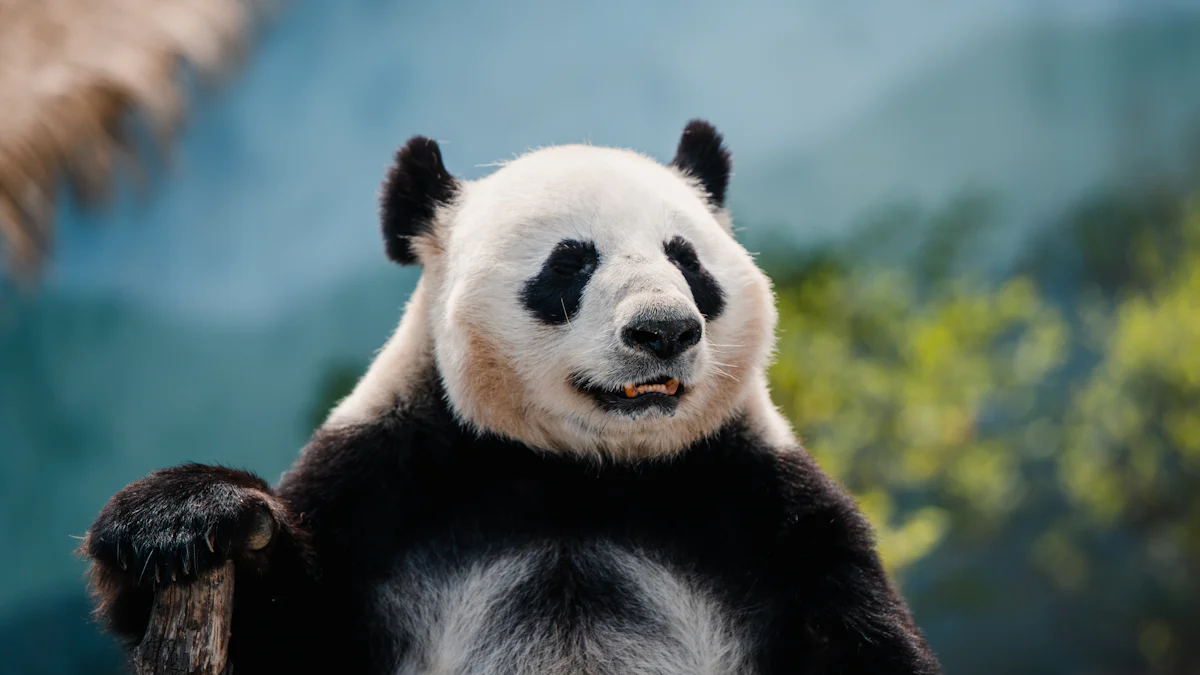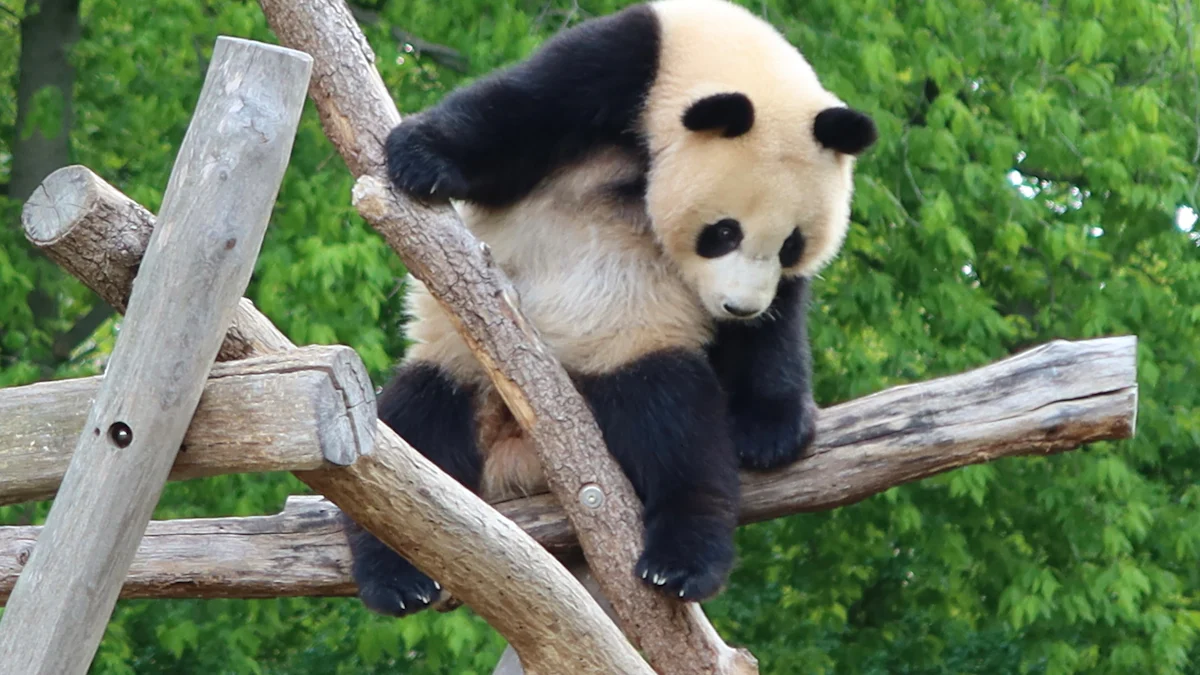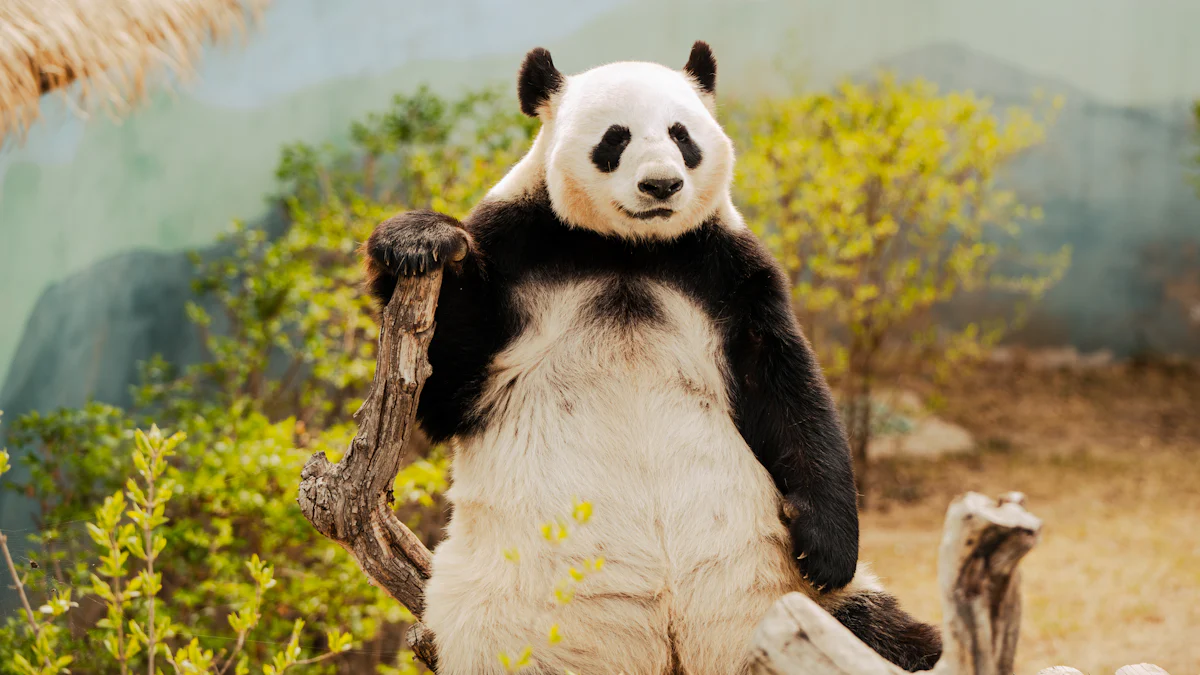
Have you ever thought about why pandas are loved everywhere? International Panda Day is a great time to honor them. Pandas are not just adorable—they are amazing animals. They have special habits like loving bamboo and being playful. Learning about them will always make you happy.
Key Takeaways
-
Pandas are unique meat-eaters that primarily consume bamboo, requiring them to eat up to 84 pounds daily to meet their energy needs.
-
Their special 'pseudo-thumb' allows pandas to grip bamboo effectively, showcasing a remarkable evolutionary adaptation that aids in their survival.
-
Pandas are symbols of peace and friendship in Chinese culture, playing a significant role in international relations through 'panda diplomacy'.
Pandas Are Meat-Eaters Who Mostly Eat Bamboo
Did you know pandas are actually meat-eaters? It seems odd since they mostly eat bamboo. Their eating habits are very interesting and affect their daily lives.
Why Bamboo Is Almost All They Eat
Pandas are part of the meat-eater group but prefer plants. Their bodies are built for meat, so bamboo is hard to digest. Because of this, pandas eat a lot—up to 84 pounds daily! They like bamboo leaves best because they have more protein. Bamboo stems don’t give as much nutrition. Pandas have strong jaws and big teeth to crush bamboo into small pieces.
Here’s the problem: bamboo doesn’t give much energy. That’s why pandas eat so much of it. They need to eat all the time to stay alive. But bamboo isn’t always easy to find. When bamboo dies, pandas must move to find fresh plants. If humans break up their habitat, this becomes even harder.
How Eating Shapes Their Day
Pandas’ lives revolve around food. They eat bamboo for 12 to 16 hours daily. The rest of their time is spent sleeping to save energy. This routine helps them survive on their low-energy diet. On International Panda Day, let’s admire how hard pandas work to stay fed!
Pandas Have a "Thumb" for Bamboo
The Role of Their Pseudo-Thumb
Have you ever noticed how pandas hold bamboo so easily? It’s all thanks to their unique “thumb.” But here’s the twist—it’s not a real thumb! Pandas have a special bone, called a pseudo-thumb, that acts like an extra digit. This clever adaptation helps them grip bamboo tightly, almost like you would hold a sandwich.
Scientists believe this pseudo-thumb evolved millions of years ago. Why? Pandas needed a way to handle bamboo, their main food source. Over time, their bodies adapted to this plant-based diet. The pseudo-thumb became a key tool for survival. But it’s not just for eating. It also helps pandas balance their weight when they walk. Pretty cool, right?
Here’s a quick breakdown of its importance:
|
Feature |
Description |
|---|---|
|
Function of Pseudo-Thumb |
Helps pandas grip bamboo and supports their weight while moving. |
|
Evolutionary Adaptation |
Developed as pandas shifted to a bamboo diet around 6–7 million years ago. |
|
Morphological Constraint |
Its size stayed small to maintain balance during walking and climbing. |
How It Helps Them Hold and Eat Bamboo
Imagine trying to eat without using your fingers. Tough, isn’t it? That’s why the pseudo-thumb is so important for pandas. It works like a built-in tool, letting them grab bamboo stalks with ease. They use it to strip leaves, break stems, and munch away. This thumb-like bone gives them the precision they need to handle their food. Without it, eating bamboo would be a real challenge.
So next time you see a panda snacking, remember—it’s not just cute. It’s a brilliant example of evolution in action! 🐼
Baby Pandas Are Surprisingly Small

Their Tiny Size at Birth
You might think baby pandas are born big and fluffy like their parents, but that’s far from the truth. When a panda cub is born, it’s shockingly tiny—about the size of a stick of butter! These little ones weigh only 86 to 138 grams, which is less than half a pound. Now, compare that to their mothers, who can weigh up to 238 pounds. That means a mother panda is roughly 900 times heavier than her newborn cub. Isn’t that wild?
Baby pandas are also born pink, hairless, and completely helpless. They can’t see or hear and rely entirely on their mothers for warmth and care. It’s hard to believe that these fragile little creatures grow into the iconic black-and-white giants we all adore.
How They Grow and Develop Over Time
The transformation of a baby panda is nothing short of amazing. In just a few weeks, they start to develop their signature black-and-white fur. By the time they’re about a month old, their eyes begin to open, and they start exploring their surroundings. At around three months, they’re strong enough to crawl and play.
By six months, panda cubs become more active and playful, often tumbling around and climbing. They also start nibbling on bamboo, though they still depend on their mother’s milk. By the time they’re a year old, they weigh around 70 pounds and are well on their way to becoming independent. Watching a baby panda grow is like witnessing a tiny miracle unfold! 🐼
Pandas Spend Most of Their Day Eating
How Many Hours They Devote to Eating Bamboo
Have you ever wondered what pandas do all day? Well, most of their time is spent munching on bamboo. It’s not just a snack for them—it’s their main job! Pandas dedicate at least 12 hours every single day to eating. That’s half their day spent chewing away. Why so much time? Bamboo doesn’t have a lot of nutrients, so pandas need to eat a ton of it to stay healthy.
Here’s a fun fact: some pandas can spend up to 16 hours eating! Imagine eating for that long every day. It’s like having breakfast, lunch, dinner, and a midnight snack all rolled into one. Pandas are basically professional eaters. 🐼
The Amount of Bamboo They Consume Daily
Now, let’s talk about how much bamboo pandas actually eat. You might think they nibble on a few stalks, but nope—they’re bamboo-eating machines! An adult panda can eat anywhere from 26 to 84 pounds of bamboo every day. That’s like eating 15% of their body weight daily.
Most pandas stick to around 12.5 kilograms (about 28 pounds) of bamboo shoots each day. But when bamboo is plentiful, they can go all out and eat up to 38 kilograms. That’s a lot of chewing! Their strong jaws and teeth are built for this bamboo feast. Next time you see a panda, remember—they’re not just cute; they’re also incredibly hardworking eaters! 🥢
Pandas Are Agile Climbers and Swimmers
How Climbing Helps Them Avoid Predators
Did you know pandas are excellent climbers? You might not expect it from their round, cuddly appearance, but they can scale trees with surprising agility. This skill isn’t just for fun—it’s a lifesaver. When pandas sense danger, they climb trees to escape predators like leopards or wild dogs. Being up high gives them a safe vantage point and keeps them out of harm’s way.
Climbing also helps pandas in other ways:
-
🐼 It gives them access to food, like tender leaves or fruits growing on trees.
-
🐾 It allows them to rest in tree branches, away from ground-level threats.
Their strong limbs and sharp claws make climbing possible. Next time you see a panda perched in a tree, remember—it’s not just cute; it’s survival in action!
Their Swimming Skills and Survival Benefits
Pandas aren’t just great climbers—they’re also skilled swimmers! If you’ve ever seen a panda paddling through water, you know how graceful they can be. Swimming helps them cross rivers and streams in search of food or new habitats. It’s an essential skill, especially when their bamboo supply runs low, and they need to explore new areas.
Water also provides a way to cool off during hot weather. Pandas will often take a dip to relax and beat the heat. Their thick fur might look heavy, but it doesn’t stop them from gliding through the water like pros. Whether climbing or swimming, pandas show they’re more than just adorable—they’re survivors! 🐾💦
Pandas Like Being Alone but Can Still Communicate
Why They Live Solo
Pandas are like shy animals who enjoy being alone. They prefer their own space in the wild. This is mostly because of their food. Bamboo doesn’t give much energy, so they eat a lot. If they shared space, they’d have to compete for bamboo. That wouldn’t work since they spend hours eating every day.
Being alone also helps pandas avoid fights. They don’t need to argue over land or food. This keeps them calm and stress-free. When pandas meet, it’s usually for a reason. They might be looking for a mate or caring for cubs. Otherwise, they’re happy exploring the forest by themselves.
How They Communicate with Smells and Sounds
Even though pandas live alone, they still stay connected. They use smells and sounds to share messages. Pandas rub their bodies on trees or rocks to leave scents. These scents tell others their age, gender, or mood. It also shows if they’re ready to mate or if an area is taken.
Pandas also make different sounds to communicate. They chirp, growl, or make a funny blatting noise. A chirp can mean they’re friendly, while a growl says, “Stay away!” Isn’t it cool how pandas talk without being together? 🐼
Pandas Have Unique Black-and-White Fur

Why Their Fur Patterns Are Important
Ever think about why pandas have black-and-white fur? It’s not just for looks—it helps them survive. Scientists say their fur has special purposes. Let’s see how:
|
Purpose |
Description |
|---|---|
|
White fur hides pandas in snow, black fur blends in forests. |
|
|
Communication |
Dark eye and ear patches warn predators and help pandas recognize each other. |
|
Ecological Adaptation |
Their fur suits them since they can’t store fat and must find food all year. |
The dark eye patches are really interesting. They might seem cute, but they warn predators to stay away. These patches also help pandas know who’s who, which is useful for finding mates or marking areas.
How Their Fur Helps Them Hide
Pandas’ black-and-white fur isn’t just bold—it’s smart. It helps them hide from predators. Black fur matches shadows and trees, while white fur blends with snow or shiny leaves. This makes it harder for predators to spot them.
Here’s a fun fact: their fur creates “disruptive coloration.” This means the black-and-white pattern confuses predators by breaking up their shape. Some pandas even have brown fur that matches the ground, giving them extra cover.
So, when you see a panda, remember—its fur isn’t just adorable. It’s a clever way to stay safe in the wild! 🐼
Pandas Are a Conservation Success Story
From Endangered to Vulnerable Status
Did you know pandas were once close to disappearing forever? In the late 1900s, fewer than 1,000 pandas lived in the wild. But after years of effort, their population has doubled. In 2016, the IUCN changed their status from "endangered" to "vulnerable." This was a big achievement! Now, over 1,800 pandas live in the wild, showing progress in saving them.
This success took a long time to achieve. People worked hard to protect panda habitats and create safe areas. In the 1980s, panda reserves covered only 570,000 hectares. By 2013, they expanded to over 2.5 million hectares! These protected spaces gave pandas room to grow and survive.
|
Year |
Wild Panda Population |
Area of Nature Reserves (ha) |
|---|---|---|
|
1980 |
909 |
570,000 |
|
2013 |
1,387 |
2,530,000 |
The Role of Conservation Efforts in Their Recovery
How did pandas make such an amazing recovery? It happened because of smart conservation plans. These efforts included:
-
Saving bamboo forests, their main food source.
-
Building over 60 reserves to connect panda habitats.
-
Studying pandas to learn about their needs and behavior.
-
Working with other countries to share ideas and resources.
Breeding programs also helped a lot. In the 1960s, only 30% of baby pandas survived in zoos. Today, over 90% survive! Now, more than 600 pandas live in captivity, helping secure their future.
Still, pandas face problems like habitat loss and climate change. But every action on International Panda Day helps protect them. Together, we can continue this amazing success story!
Pandas Are Important in Chinese Culture
What Pandas Mean in Chinese Traditions
Pandas have been special in China for many years. They stand for peace, friendship, and joy. During the Tang Dynasty, pandas were given as gifts to other countries. This was a way to show kindness and goodwill. Even now, pandas are symbols of harmony in Chinese culture.
Pandas are often seen in Chinese festivals and events. For example, during Lunar New Year, panda costumes bring happiness and luck. Their calm and playful nature makes them perfect for celebrations. Pandas also appear in events about saving the environment. They remind people to protect nature and care for the planet.
How Pandas Help Build Friendships
Did you know pandas help countries get along? This is called panda diplomacy. It started long ago but became official under Mao Zedong. Instead of giving pandas away, China now lends them to other nations. This shows how pandas help build strong relationships.
A famous example happened in 1972. China sent two pandas, Ling-Ling and Hsing-Hsing, to the US. This gift helped improve US-China relations during the Cold War. It showed friendship and reduced tensions. Today, pandas still act as symbols of peace and cooperation.
On International Panda Day, let’s celebrate pandas for their cuteness and their role in uniting people and countries.
Pandas Have a Playful and Endearing Nature
How They Love to Tumble and Play
Pandas are like the clowns of the animal kingdom. They love to tumble, roll, and just have fun. You might see them somersaulting down hills, crashing into each other, or sliding on their bellies like furry sleds. It’s almost as if they’re putting on a show just to make you smile.
Their playful antics don’t stop there. Pandas often climb trees just to hang upside down or swing from branches. Sometimes, they even wrestle with each other in the most adorable way. Watching them play is like seeing pure joy in action. Even panda moms get in on the fun. They hold their babies in the cutest, clumsiest ways—sometimes even upside down! It’s a mix of love and silliness that’s impossible not to adore.
🐼 Fun Fact: Pandas’ playful nature isn’t just for fun—it helps them build strength and coordination as they grow.
Why Their Playfulness Captures Hearts Worldwide
There’s something magical about watching pandas play. Their silly, carefree behavior reminds you to enjoy the little things in life. It’s hard not to laugh when you see a panda rolling down a hill or wrestling with a friend. They’re like big, fluffy comedians who don’t even know they’re funny.
Pandas also have a way of connecting with people emotionally. Their playful nature makes them seem approachable and relatable. You can’t help but feel happy when you watch them. That’s why pandas have become global icons of joy and positivity. They’re not just animals—they’re happiness wrapped in black-and-white fur! 🐾
Pandas are amazing animals, don’t you think? They eat a lot of bamboo—about 15% of their weight daily. Their special “thumb” helps them hold bamboo easily. Their black-and-white fur isn’t just cute; it helps them hide. Also, pandas can live up to 30 years in zoos!
International Panda Day shows why pandas need our help. It teaches us about their problems, like losing their homes, and encourages action. You can help by adopting a panda, volunteering, or supporting conservation groups. Even small efforts can protect these gentle creatures!
FAQ
How long do pandas live?
Pandas can live up to 20 years in the wild. In zoos, with proper care, they can live even longer—up to 30 years! 🐼
Why do pandas eat so much bamboo?
Bamboo has low nutrients. Pandas need to eat a lot—up to 84 pounds daily—to get enough energy to survive. That’s why they spend hours munching!
Can pandas survive without bamboo?
No, bamboo is their main food. Without it, they’d struggle to survive. Conservation efforts focus on protecting bamboo forests to ensure pandas have enough to eat.
🐾 Tip: You can help pandas by supporting organizations that protect their habitats!





